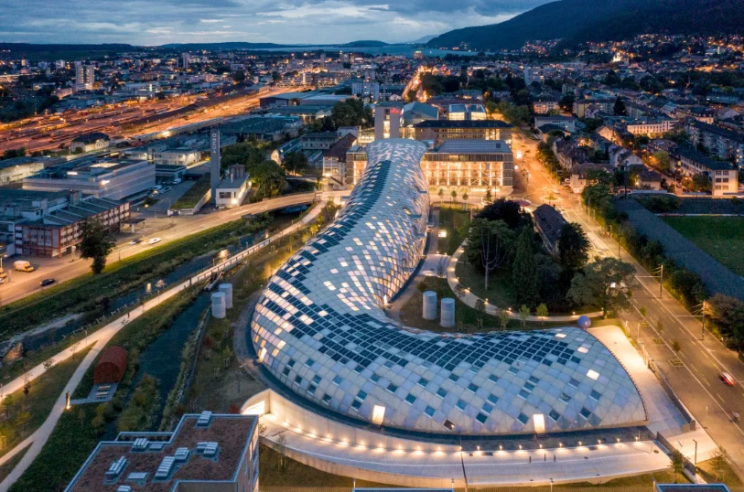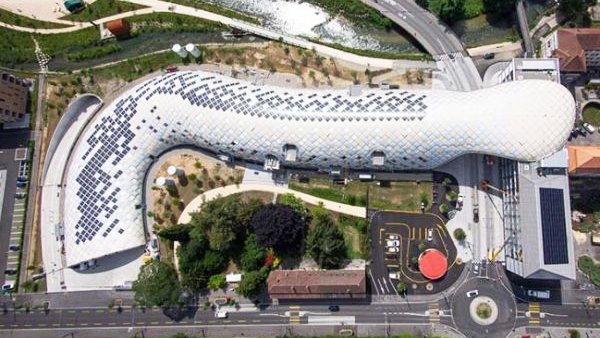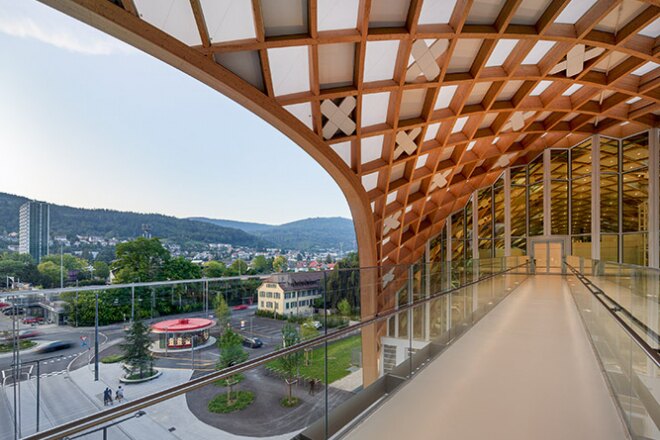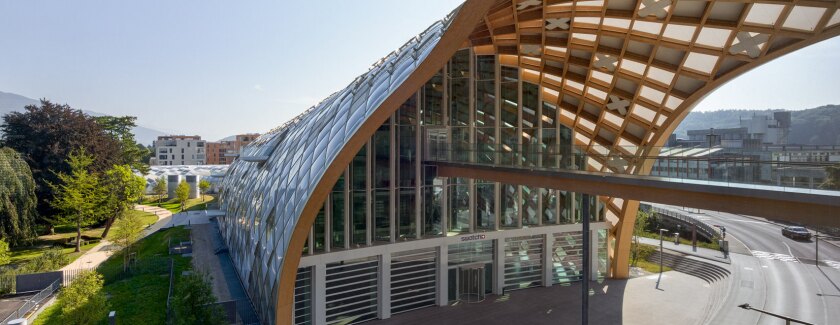05 Ago NIKOLAS G.HAYEK-(1928-2010)
Pubblicato alle 00:54h
in
News
da Italia Nostra Genova
.
Nel 1999 Nicolas G. Hayek rileva una delle gemme dell’ Alta Orologeria svizzera ma con una immagine appannata : Breguet. Spinto da un’autentica passione, infonde una vitalità senza pari in un marchio depositario di un patrimonio storico eccezionale.

tag:marchi storici/arte applicata
L’arte orologiera è uno degli emblemi della Svizzera nel mondo. Questa immagine si basa su una lunga tradizione che affonda le sue radici nel XVIII secolo, ma deve molto anche alla figura di Nicolas G. Hayek (1928-2010), un imprenditore che ha segnato in modo indelebile questa antica industria.
La Facoltà di Conservazione dei Beni Culturali di Bologna, qualche anno fa, ha conferito la Laurea ad honorem a Nicolas Hayek Senior per l’intreccio tra tecnologia ed espressione della autocoscienza sociale del suo lavoro e per le sue capacità manageriali che lo hanno reso un esempio eccelso di operatore dei beni culturali. E’ stato membro del Consiglio di ricerca, tecnologia ed innovazione per il futuro dell’Europa, consigliere economico di diversi governi europei, Presidente della Swatch , della joint-venture tra SMH/Swatch e Mercedes-Benz e del Comitato Direttivo della Hayek Engineering. All’interno dello Swatch group ha giocato un ruolo decisivo nello sviluppo del Gruppo con le sue marche storiche di orologi(Breguet, Omega, Longines, Tissot). Le strategie che egli ideò e sviluppò dagli inizi degli anni ’80/90 riportarono al successo l’intera industria orologiera svizzera che così riconquistò la sua posizione dominante nel mondo intero. Le industrie dirette da N. Hayek, al di là dei loro successi economici, hanno profondamente investito il settore dei beni culturali e delle arti applicate facendo della tecnologia dell’orologio e della sua realizzazione oggettuale un veicolo di cultura e di comunicazione fra le classi di età e i livelli sociali dei vari popoli del mondo. La Laurea-Le ricerche di Pomjan e gli studi sul computo del tempo di Borst pongono la misurazione del tempo come radicale bene culturale e come percezione a priori della storia e della rappresentazione del mondo, una struttura di lunga durata che il nostro futuro mutua direttamente dalle tecniche computistiche del medioevo, per cui nelle nostre lingue due dei termini più legati allo sviluppo futuro, conto e computer, derivano dal computus medievale. L’orologio è così diventato un bene culturale in sé nella tradizione occidentale.Il Tempo è stato interpretato ed espresso nella sua realtà e nella sua iconologia dagli orologi di Hayek. Sono diventati marchi di eccellenza in tutti i segmenti di mercato, esprimono la autocoscienza e l’ autorappresentazione assurgendo a stilema inconfondibile e ad elemento dell’arredo immaginario personale. Le varie marche degli orologi di Hayek compongono un museo del gusto dell’ultimo trentennio e forniranno agli storici del costume il diagramma espressivo” delle identità culturali confluite nel contesto della città mondiale odierna”.

INTERVENTO DI NIKOLAS G. HAYEK
March 5, 2010,
Il Paul Scherrer Institut PSI è il più grande centro di ricerca per le scienze naturali e ingegneristiche in Svizzera. I lavori di ricerca si concentrano su tre aree tematiche centrali: Materia e materiale, energia e ambiente, uomo e salute. Il PSI sviluppa, costruisce e gestisce impianti complessi per grandi ricerche. Ogni anno, più di 2200 scienziati provenienti sia dalla Svizzera che dal resto del mondo si ritrovano al PSI per eseguire nei suoi straordinari impianti esperimenti che non sono possibili altrove.
PSI Paul Scherrer Institute.
On the eve of the renewable energy age – how important is the contribution and role that Switzerland could and should play in this explosive time of radical change ? by Nicolas G. Hayek, Chairman of the Board of Directors of The Swatch Group Ltd. and of Belenos Clean Power Holding Ltd.
Ladies and Gentlemen, Dear Colleagues, In 1948, after the end of one of the most devastating wars that shattered our planet, I was a young student just finishing my ‘études supérieures’ in mathematics, physics and chemistry. And as most young scientists-to-be in those days, we all believed that nuclear energy – despite the immense and appalling destruction caused by the first atomic bomb attack about 3 years before – would provide all the energy needed for the future at very low cost and all over the world. Nobody really considered civilisation’s everincreasing CO2-emissions or their impact on the environment, because these were just not significant issues at that time. However, what we did already know was that the only energy sources, readily-available in huge quantities and at relatively low cost, but certainly not renewable, were oil, gas and coal. And we expected that all these oil, gas and coal reserves (fossil fuels) would be consumed within a few decades, and because these reserves were all situated in faraway countries, we believed they would become more expensive and more difficult to distribute. Nuclear energy was the future, it seemed clean, relatively safe and could be used and produced locally in all countries without long distribution distances, despite the fact that the atom bomb had dampened our enthusiasm and somewhat reduced our confidence in this energy source. Based on the same thinking, the ETHZ, the Swiss government and Swiss industry created around 1970 here in Villigen, the Swiss Institute for Nuclear Research (SIN), a few years after the creation of the Swiss federal institute for reactor research (EIR), located just on the other side of the river in Würenlingen.
Both institutes had specific nuclear research missions: • the EIR to develop all the expertise and industrialisation of reactor development and its various components and • the SIN to develop nuclear research for civil use in all fields in Switzerland. Today in 2010, 62 years later (in 1948 I was just 20 years old), if we make an analysis of how we stand in this regard, we will find a dramatic change of thinking about this issue. First of all, during the last 60 years, humanity has evolved and experienced enormous changes in the quality of our atmosphere and environment. Our planet Earth has seen radical deterioration in this area and after a long period of ignorance, disbelief and lack of concern, all the major governments of the world finally recognised that the overheating of our atmosphere was directly related to the emission of CO2 gases, caused not only by the huge increase in the number of cars, trucks and other vehicles ensuring our full mobility every day, but also due to the CO2 produced by the fossil fuels from our homes and factories – these emissions are seriously endangering the survival of planet Earth and pose a considerable threat to our climate security. The second very important and immediate environmental problem was historical and concerned the disaster of April 1986, when one of the nuclear reactors exploded at a power plant in Chernobyl in the Ukraine. This monumental catastrophe, together with a few other less fatal incidents (Harrisburg in 1979 and others) added to the unresolved problems of endstorage, created a very strong popular movement against the increased use of nuclear plants, and forced many major governments in Europe and other countries to prohibit the construction of new nuclear plants for energy production. In the US no construction permits have been issued for the last 20 years, although Barack Obama is currently in the process of reintroducing these permits. A nuclear fusion solution that could ensure clean and less dangerous energy production involving enormous investments – currently being researched by the international industrial community in countries such as France (for Europe) and the United States – is still a long way from becoming reality, as well as being far too expensive, at least for the moment. Maybe in the future it will become a clean and lower cost source of energy, but the significant issues regarding energy storage, individual transportation and handling for the mobile sector can’t be solved by nuclear fusion either. For all these reasons the Swiss Federal Government and the Federal Institute of Technology in Zurich and naturally also the nuclear industry itself, had to totally rethink the strategy, utility and missions of the EIR and SIN institutes. This was around the beginning of 1985. Many industrialists, politicians and others in Switzerland voiced their opinions about closing al east one of the two institutes, many were even thinking of closing both. At that time, I was asked to study this problem and provide a recommendation on the strategy to be followed in this field. This was in 1985, beginning 1986 at a time when I was already analysing the strategy and management of both ETHs and their affiliated institutes with Hayek Engineering. To assist us in this analysis in order to define a strategy for the future of EIR and SIN, we engaged the consultancy services of 4 internationallyrenowned and respected scientists, experts in the domain of nuclear research and nuclear energy production: • Professor W Häfele, Chairman of the Nuclear Research Institut Jülich, Germany • Professor J Teillac, President of the High Commission for Atomic Energy in France • Professor P Aigrain, scientific consultant to the Board of the ThomsonBrandt-Group in France, and formerly a member of the French government • Dr G Manning, executive of the Rutherford-Appleton Laboratory, England Ladies and Gentlemen, it was a fantastic pleasure for me to go through our archives and review the enormously heavy and voluminous documents that we prepared at the time. Our 1986 recommendations, a merger between the EIR and SIN, were approved by the ETH, the Swiss government, the Swiss parliament and by the industry itself and the result was the PSI. And I wouldn’t have mentioned it today, were it not a milestone in our thinking about renewable energy of the future. Today I am extremely proud to see how the PSI has evolved, its industry reputation for research and development and its achievements are invaluable. I was reminded of the press conference which we conducted in the PSI lab about one and a half years ago (30 May 2008) when we announced the start of our fuel cell programme. Whilst visiting the same laboratory area last week; the lab was full of the latest, high-tech, state-ofthe-art testing equipment and several fuel cell prototypes. Fuel cell tests were being carried out in several of these testing units, and as I looked across the lab a few meters further away, other young scientists were conducting important work for the CERN. This is precisely the large scope and depth of work we dreamed of achieving when the merger was decided in 1986/87, and the PSI has by far exceeded our expectations. The PSI is proving daily how important and essential its work is for all of us. The phenomenal industrial growth, development and population expansion in emerging countries including the Far East, Australia, South America, the Middle East and Africa, not forgetting Europe itself, as well as the Russian Federation and the United States of America – has led to an enormous increase in the energy requirements of each individual, and all these factors require more and more energy to maintain a better standard of living. Today fossil energy sources still account for by far the largest proportion of energy used. However, the problems that they create have increased enormously – the CO2 emissions alone, which have an extremely detrimental impact on the environment, provide a valid enough argument to stop using them; on the other hand the price increase of oil and gas over the last 40 years shows a very strong dynamic to continue, coupled with the fact that certain countries (predominantly major oil and gas producers) could potentially blackmail politically other countries which do not possess these fossil energies on their territories. And last but not least, the costs together with the health and safety risks associated with the transportation of these fossil energies are enormous. The price of oil and gas is currently stable after several periods of price increases, and we now know that all our reserves will be exhausted in the not too distant future. This is a very dangerous development for our spaceship earth. For practically all the five following reasons, I repeat: • Protection of the environment • acceptable prices • limited reserves • political blackmailing • transportation costs and transportation risks It requires us to find very, very, very, quickly and I must reiterate, very, very quickly alternative clean, renewable energy solutions to satisfy our ever-growing demand for energy. Naturally most countries do indeed plan to reduce their respective energy consumption and technically there are many ways to save energy, for example better insulation of our buildings, or by improving the performance of car engines. These measures could generate anything from between 25% up to even 50% energy saving. It is precisely for this reason that politicians from all over the world congregated recently in Copenhagen to discuss the ways in which to achieve improvement in this field and lower the CO2 emissions in the atmosphere. Ladies and Gentlemen, we all know that in this regard politicians do indeed have very good intentions, but they are not going to be able to solve these problems efficiently for many reasons. First of all, the world population is increasing constantly, and second the standard of living of all the Earth’s inhabitants is also increasing at a very rapid rate. Consequently, the vast majority of consumers is purchasing new cars, trucks, machinery, household appliances, they need heating in their new homes, etc. Society cannot be legally forced to reduce its total energy consumption or emissions, even if billions are paid in compensation to poor developing countries or to our own people. Furthermore, any government, democratic or otherwise, which even attempted to force reduction in energy consumption, would be completely destroyed by public pressure. Efforts to reduce emissions will be invalidated by the population growth and substantial increase in its energy requirements.
Only scientists and researchers together with entrepreneurs ‘movers and shakers’ will be able to resolve all the afore-mentioned energy problems. The sun is an enormous fusion star which has kept this planet alive for billions of years (since the beginning of life and creation itself) by producing and sending huge amounts of energy to earth every day. This exorbitant quantity of daily energy is reportedly 5 000 times more than the world’s current population can use. In recent times (over the last 4 000–5 000 years) human beings have always actively harnessed the sun’s energy. We learned how to capture solar energy with mirrors to create heat, fire and power, and with the recent introduction of photovoltaic cells, we learned how to transform it directly into electricity. And we are rapidly learning how to store it in safely transportable devices. But both processes must be improved, firstly because the current photovoltaic module efficiency at reasonable cost is no more than 10% to 14%, which in the short-term is totally unacceptable, and secondly because the existing electricity storage devices and systems are inefficient and too expensive. The NASA and other significant developers have indeed achieved a module efficiency rate of 30–40%, which as far as I’m concerned is still not enough for the future. And this rate was attained using highly expensive materials, making this system difficult for widespread general use at the present time. Our efforts must be concentrated on finding ways and means to convert more than 50% of the directly captured solar energy to electricity, with a pricing structure similar to that of the fossil energy in current use and all the benefits for the environment. Switzerland has very prominent researchers with extensive experience in this field, for example at the IMT in Neuchatel, the EMPA in Zürich, the PSI, the Swiss Federal Institutes of Technology (ETHs) and other research institutes, as well as several internationally-recognised industrial groups, which are able to develop new systems, new ideas and new materials. I am convinced that if research efforts are totally focused, it is viable to achieve significantly better performance within a relatively short period of time, say between 5 maximum 10 years. Another area of paramount importance is the need to individually transport this energy safely and securely over thousands of kilometers, for example in our vehicles and in transport containers, thus enabling us to operate our mobile-systems, cars, trucks, trains, airplanes, etc. with exactly the same comfort, range, security and price as with fossil energy today, but in a cleaner and much more readily-available manner. Newly-developed fuel cell systems at acceptable costs operated with decentralised production of hydrogen and oxygen or hydrogen and air, are one of the solutions. Scientists and researchers from the project leader PSI, together with those from Belenos and engineers from the Swatch Group are developing an efficient fuel cell, working with hydrogen and oxygen, and it will be ready this year. Where are we going to get our fuel for this fuel cell – hydrogen and oxygen? Belenos has created a joint venture for this fuel production called Swiss Hydrogen Power – SHP with Groupe E, the electric power company of Fribourg and the Cantonal Bank of Fribourg. We plan to produce this hydrogen and oxygen fuel individually decentralised in private homes, for example with photovoltaic cells, electric power and water electrolysis. We hope to be able to produce an appliance similar to a medium-sized washing machine, which would produce enough hydrogen and oxygen for a fuel-cell car to cover an average of 13 000 to 15 000 kilometres per year. The fuel tank will have the capacity to cover between 500 and 700 km as is the case with fuels in use today, and the fuel cell could certainly in the short-term solve the car fuel problems facing the automotive industry. It will be available for widespread application relatively quickly, although according to past experience, there is no guarantee that the auto industry will indeed adopt it for use in intensive trials any time soon. However, I must admit that serious approaches have been made by certain important automotive producers, to gauge the possibility of conducting our trials in their cars, but remember these are only discussions even if initiated by the industry itself. We hope that our results will be so conclusive that we will convince them to collaborate with us to speed up the industrialisation process and subsequent market deployment. A completely different system for vehicles is also being developed with a high-volume capacity safety container to store electric power, also enabling long range distances of at least 500 and 700 kilometres to be travelled, very rapid recharging and all this at a reasonable cost. I know that most of you will immediately tell me that this is an impossible dream to fulfill, but I will explain to you later why we believe that such possibilities exist, but will indeed require a hell of a lot of work, innovation capacities and time to achieve the expected, wonderful results for humanity. We know that in addition to Belenos, many other institutes, researchers and companies in several countries are working in this field, both in fuel cell development and electric containers. It’s imperative that we get groundbreaking results very soon. The environmental damage, coupled with the enormous increase of the population and the corresponding increase in their energy requirements, do not give us limitless time to solve these problems. My own personal experience in research, innovation and production has convinced me that only a strong alliance between real innovative entrepreneurs ‘movers and shakers’ and flexible, highly-gifted creative researchers, such as physicists who are confronted every day, on the one hand with the vast infinity of the universe and on the other with absolutely minute particles of matter, which both still hold the many unsolved secrets of our existence – it is precisely for this reason that they still believe in, or at least do not exclude miracles and can accelerate the resolution of these problems and the production of such renewable energies. This is why I created Belenos Clean Power Holding Incorporated, a blend of highly-dedicated and financially-strong, innovative and experienced entrepreneurs, with highly-committed researchers, able to think ’out of the box’ and find ways to develop new renewable energy systems. Such a dynamic combination should be able to achieve results considered impossible today. But Belenos is only one of many working groups that should be established in Switzerland. This our country has an extraordinary concentration of talent, a wealth of expertise and immensely skilled individuals working in all scientific fields. All these experts should be brought together to be the driving force in pioneering renewable energy systems for the future. I cannot emphasise enough that Switzerland can and should play a major role in finding these solutions in the coming years. We have, as mentioned a large number of researchers and expertise and many highly-educated entrepreneurs, who are ’movers and shakers’ with substantial financial resources. Let’s mobilise all of them without relying on government or taxpayer’s money. If we can unite and coordinate all these experts and talent, in 5 to 7 years all our main energy problems will be solved. Switzerland has many advantages that will allow us to make a significant contribution to finding innovative solutions to the energy problems. As I already mentioned there are a substantial number of scientists throughout the country specialising in practically all the relevant areas. Switzerland is also one of the few highly-industrialised nations which does not have any national oil or gas producing companies or lobbies; nor does it possess an established automotive industry manufacturing vehicles or engines, with major investments to amortise quickly when they become obsolete as a result of new energy systems. All efforts can thus be wholly concentrated on the creation of renewable energy systems. Many of our scientists have studied and lectured at overseas universities, and have worked closely with research institutes or industrial companies in the US, Japan, other European countries, Australia and South Africa. They continue to maintain very good relationships with the international scientific and industrial community and exchange experiences – all these factors together with our cross-cultural diversity and understanding of other foreign languages are also a huge advantage. As I have already mentioned, Switzerland also has a large number of industrial companies with relatively important financial capabilities, which means that there are enough financial resources to meet all requirements in terms of research, development, manufacturing and distribution. And last but not least, any new product developed with renewable energy will certainly provide a strong return on our investments. Because in our society any new product that helps to improve the quality of life at a reasonable cost, and which is used on a daily basis, is guaranteed a positive return on any investment. Within these parameters new products create new wealth and new jobs and attract all the prerequisite talent, equipment and intelligence. When such an investment is rewarded by such encouraging results substantial financial resources will automatically be forthcoming. In this regard I myself receive many requests from companies offering to invest in the projects of Belenos. These are the foundations on which we created Belenos just over two years ago (18 December 2007). Some of you may not know that for over twenty years I have been actively involved in trying to create new clean energy systems, especially for cars. As stipulated in the contract the Swatchmobil, subsequently a hybrid vehicle, should have been manufactured with Volkswagen and then with Mercedes when we created the Smart factory; unfortunately, this project was terminated because of lack of confidence and understanding of product strategy by the then management of our partner Mercedes. This experience proved to me that success in such endeavours can only be achieved if separated from the top management of the automotive industry, in fact from the automotive industry itself for many, many reasons. First of all, the undisputed and essential requirements of total and absolute security for cars is, for many top car executives, the deadly enemy of substantial innovation. They are ready to innovate in certain clearly defined and limited areas, but they will only make a complete revolution if forced to do so. Secondly, the best car engineers and developers and the most brilliant ones in the current automotive industry are highly-trained mechanical engineers. These experts have vast knowledge of millions and billions of precise, technical details, every nut and bolt in a car; however, they don’t possess much knowledge or confidence in electronics, physics, chemistry and other technical fields required to make a complete revolution in the energy systems of cars. I lived and worked with many of them for years, and besides the fact that they don’t know very much about other technical fields, they actually have very little confidence in the scientists specialising in those fields, so that trying to convince them to push new systems intensively has been a very hard and disappointing task over the last few years. Thirdly, billions of dollars have been invested in equipment, logistics and systems for engines and parts of the car based on existing fuel sources; therefore, automotive manufacturers must target and ensure profit and amortise these investments, before jumping too quickly to new systems. And to conclude, even the smallest car manufacturers are huge companies, their top management being comprised of very highly-paid executives, and the motivation to push dynamically and strongly into new fields, with the potential danger of failure, is practically non-existent. If you make and launch a new car with completely new energy systems and it does not perform perfectly within the first year, you will be fired. That’s why Belenos is going to create new systems and when they are completed and technologically-proven, we will deliver them to the industry or to the general public. For example we are going to conduct trials on cars with our fuel cell and our hydrogen/oxygen production at the end of this year, beginning of next year. Belenos is a holding company using its own capital and financial resources, which does not depend in any way on financial contribution from the government or the taxpayer. This holding company is owned, operated and financed by a select number of shareholders, only efficient, realistic scientists and entrepreneurs who are ’movers and shakers’. This holding company is ready and willing to create joint ventures for individual renewable energy projects with any third parties in industry, research institutes, power companies, even with governments and other entities. Belenos is a company with the mission to research, develop and produce new innovative energy products/systems. The number of joint ventures that Belenos is ready to enter into and finance (51% and more) is theoretically unlimited. We can create 10 to 20 or more projects in the field of renewable energy, if they are realistic and with solid potential. Every viable endeavour is given careful consideration and in-depth analysis, and naturally we are looking for additional scientists and entrepreneurs to become partners in these joint ventures. Four joint ventures already exist and two more are currently under development: i) Fuel cell with PSI Æ practically all known fuel cell developments use hydrogen and air, whereas the PSI/Belenos fuel cell technology project is probably unique in using hydrogen and oxygen on a real industrial scale. This fuel cell has been developed over the last two years by a highlydedicated and efficient team of scientists from the PSI, together with Swatch Group electronic engineers and other scientists from Belenos and Swatch Group who have all given an outstanding performance. A 10kW prototype has been successfully developed.
Encouraging results with respect to lifetime and cost have also been achieved. Furthermore, a 25kW stack and system are being developed to be also specifically industrially produced. ii) with Groupe E and the BCF (Banque Cantonale Fribourg) Æ Swiss Hydrogen Power (SHP) is evaluating different scenarios for the flow of electricity between photovoltaic cells, the electric grid and the electrolyser to generate the two gases, hydrogen and oxygen. In addition we are also developing the gas containers and the filling stations which will facilitate the transfer of these gases from the containers situated in the home, to the containers in the car. iii) a renewable energy planning and consulting Engineering company with Swatch Group and Hayek Engineering Æ this joint venture will conceive, plan and supervise the use of renewable energy in: − the homes of private individuals − industrial buildings − other areas to be explored This company will be driven by market demand and will determine the most optimal solution on a case-by-case basis. iv) and a classified project called NGH Containers v) A joint venture to create a campus for research and production of high-efficiency, low cost photovoltaic cells and last but not least vi) a further classified project for a container for the storage and individual transportation of power. I wish to emphasise yet again that Belenos is an institute focusing on developing renewable, energy sources and not a financial institution providing capital for such projects. We wish to work with, control and manage all the research development and production programs through our own scientists, or partner scientists of the joint ventures and our entrepreneurs. In our future joint ventures not only scientists, research institutes and entrepreneurs will be welcome, but also large international companies such as Nestle, BBC, Schindler, Novartis, Hofmann La Roche, etc. to name but a few and naturally also entities from the international community outside Switzerland. This kind of organisation has proved to be much more efficient and flexible and costs much less than a disorganised, chaotic and decentralised approach with hundreds of inventors and institutions running around trying to obtain financing from governments banks or industry, with many of them working on the same research element.
Private initiative can also, ladies and gentlemen, in a highly democratic and free-thinking, independent and individual-oriented country like ours, be coordinated or concentrated in such a way that research efficiency is strengthened. We tried to find a way to carry out this coordination ourselves as entrepreneurs and scientists – if we create a core with powerful, magnetic appeal we can attract most of the highly-gifted people and accelerate the process in such a way that it will be beneficial for all concerned.
I admit it’s difficult, but in the interests of all concerned we will keep trying to do it.
.
LA NUOVA SEDE
L’architetto: Shigeru Ban Nato nel 1957 a Tokyo e vincitore del Premio Pritzker nel 2014, Shigeru Ban è noto per la delicatezza delle sue strutture, i suoi metodi anticonvenzionali e il suo decisivo contributo all’innovazione e all’umanità nell’architettura. Il Gruppo Swatch ha collaborato per la prima volta con l’architetto al Nicolas G. Hayek Center di Tokyo, inaugurato nel 2007. Nel 2011, il suo progetto ha vinto il concorso di architettura indetto dal Gruppo Swatch per la realizzazione della nuova sede di Swatch, della nuova manifattura Omega e della Cité du Temps. Il progetto si è rivelato particolarmente convincente grazie al suo concept originale seppur pragmatico e all’abilità dimostrata nell’infondere il peculiare spirito del brand a ciascuno di questi edifici. Inoltre, Shigeru Ban ha preso in considerazione il paesaggio e gli edifici esistenti integrandoli nel progetto generale.
Architettura Scintillante e sinuosa, la struttura del nuovo edificio è lunga 240 metri e larga 35 metri. Nel punto più alto, la facciata misura ben 27 metri. Pur fondendosi con grazia e armonia nell’ambiente urbano circostante, l’innovativo progetto rompe i classici schemi architettonici degli edifici adibiti a uffici. Le forme di questa struttura solleticano l’immaginazione: come un’opera d’arte, l’interpretazione viene lasciata agli occhi di chi osserva. Con una superficie di oltre 11’000 m², la facciata a volta si erge con delicatezza verso l’entrata per poi trasformarsi nella Cité du Temps. L’esterno e l’interno dell’edificio sono un tripudio di temi ricorrenti, forme bombate, colori, trasparenze ma anche materiali ed elementi costruttivi classici utilizzati in modo del tutto originale. Un’imponente struttura portante in legno (grid shell) caratterizza l’ampia facciata. Il materiale tradizionale è stato scelto per due motivi: è ecologico e sostenibile. Inoltre, il legno può essere lavorato facilmente e tagliato per ottenere pezzi molto precisi: proprietà importanti per una costruzione in cui ogni millimetro conta. Durante la progettazione, una moderna tecnologia 3D ha consentito di determinare la forma e l’ubicazione esatte delle circa 4.600 travi del reticolato in legno.
Mediante un sofisticato principio a incastro, le singole travi sono state perfettamente inserite l’una nell’altra. Dovendo assolvere alla funzione di ampia facciata con uffici, il reticolato in legno doveva anche soddisfare diversi requisiti tecnici. E difatti una complessa rete di cavi è integrata in maniera discreta nella struttura. Durante i lavori di costruzione della struttura in legno, è iniziata l’installazione dei circa 2.800 elementi a nido d’ape (timber grid shell) che costituiscono la maggior parte della facciata. Ogni elemento è stato scrupolosamente realizzato su misura a partire da 50 pezzi singoli e adattato alla funzione e all’ubicazione a cui era stato destinato. Si possono distinguere tre tipi di elementi di base a nido d’ape: quelli opachi, quelli semitrasparenti e quelli trasparenti. Gli elementi opachi di forma regolare coprono la maggior parte delle strutture a nido d’ape. Si tratta di elementi chiusi con una pellicola esterna opaca molto resistente alle intemperie, la cui funzione principale è proteggere dai raggi solari. Alcuni di questi possono essere aperti fungendo da griglia di aerazione, mentre altri sono dotati di pannelli fotovoltaici. Gli elementi semitrasparenti a cuscinetto, invece, sono gonfiati con aria e presentano al centro lastre di policarbonato semitrasparenti per l’isolamento termico. I cuscinetti, in grado di sopportare anche il peso della neve o del ghiaccio, sono ventilati in modo leggero ma costante affinché siano sempre sotto tensione. Gli elementi trasparenti sono realizzati in vetro e per l’isolamento termico sono state impiegate quattro lastre di vetro, tra le quali è stato incorporato un avvolgibile bianco. Anche questi elementi sono sempre leggermente ventilati per prevenire la formazione di condensa. Nove balconi di dimensioni comprese tra 10 m² e 20 m² offrono una panoramica su diversi piani. Dei puntini bianchi sulle superfici di vetro fungono da protezione solare. Grazie alle sottili perforazioni, 124 croci svizzere in legno montate a soffitto migliorano l’acustica degli ufficiAll’interno dell’edificio, una superficie di 25.000 m² si snoda su cinque piani ospitando tutti i reparti di Swatch International e Swatch Switzerland. La superficie dei quattro piani superiori si riduce progressivamente, mentre le gallerie con balaustre in vetro offrono una panoramica sui livelli inferiori. Oltre alle aree di lavoro tradizionali, diversi spazi comuni sono distribuiti lungo tutto l’edificio: una caffetteria situata al piano terra – aperta a tutti i dipendenti Swatch e ai loro visitatori – e piccole aree dedicate al relax, in diversi punti all’interno dell’edificio. Per i momenti in cui è necessaria un po’ di riservatezza, “alcove separate” accolgono fino a sei dipendenti per effettuare chiamate o concentrarsi sul lavoro. All’estremità posteriore del secondo piano si trova un’installazione particolarmente insolita: una scalinata che conduce in alto, verso il nulla. È conosciuta con il nome di “Reading Stairs” (letteralmente “scala di lettura”): gli scalini che la compongono e la vista che offre invitano i visitatori a ritagliarsi spazi per pensare e dare libero sfogo alla fantasia. Cinque esemplari di Bucida buceras (una specie di olivo originario dell’America centrale) si stagliano fino a raggiungere un’altezza pari a due piani. Queste piante sempreverdi apprezzano la temperatura ambiente e conservano tutto l’anno le foglie sottili. I sotterranei si estendono su tutta la lunghezza dell’edificio. Oltre ai locali tecnici, all’impianto di ventilazione e all’archivio, ospitano anche un parcheggio con 170 posti auto e 182 parcheggi per biciclette.
L’uso intelligente della falda acquifera per il riscaldamento e il raffreddamento dell’edificio e dell’energia solare ricavata dall’impianto fotovoltaico contribuiscono notevolmente a mantenere un ottimo equilibrio delle emissioni di CO2. Tecnologie all’avanguardia e grande know-how hanno consentito di realizzare un sistema di bikesharing Velospot, stazioni di ricarica, vetri e vetrate schermati intelligenti, lampade a LED, sistemi di ventilazione altamente efficienti, impianti ad attivazione termica della massa e uffici in cui non si fa uso di carta. Il nuovo edificio Swatch dimostra così che l’edilizia e i metodi di lavoro moderni possono essere in armonia con la natura. Per la costruzione, è stato utilizzato unicamente legno (per la maggior parte abete) proveniente da boschi svizzeri. Sono stati necessari poco meno di 1’997 metri cubi di materiale: una quantità che impiega meno di due ore a ricrescere. Il concept energetico si basa sul ricorso all’energia solare e alla falda acquifera e consente il funzionamento autonomo degli impianti di base, quali la ventilazione, il raffreddamento, il riscaldamento e l’illuminazione dell’edificio della sede Swatch e di quello della Cité du Temps. La falda acquifera garantisce il riscaldamento e il raffreddamento del nuovo edificio Swatch, che condivide tali risorse con le strutture vicine, la Cité du Temps e il nuovo stabilimento produttivo Omega, in attività dal 2017. Nove pozzi sotterranei e due ex serbatoi di gasolio convertiti in serbatoi di acqua sono distribuiti su tutta l’area. 442 elementi solari bombati, fabbricati singolarmente, sono stati inseriti all’interno della facciata a nido d’ape. Grazie ai 1’770 m² di pannelli fotovoltaici, vengono prodotti circa 212,3 MWh di elettricità all’anno, equivalenti al consumo medio annuo di 61 famiglie.
Architetto: Shigeru Ban (nato nel 1957 a Tokyo/Giappone, vincitore del 36° premio Pritzker) Facciata: – 11’000 m² – 4’600 elementi in legno 100% svizzero – 2’800 elementi a nido d’ape realizzati con fino a 50 pezzi lavorati singolarmente su misura – 9 terrazze di superficie compresa tra 10 m² e 20 m² Hall: – 22 m di altezza – All’altezza di 5,5 m inizia una vetrata a zigzag che si estende fino a un’altezza di 22 m – Ogni porta di ingresso in vetro pesa 1 tonnellata
Edificio: – Lunghezza 240 m, larghezza 35 m, altezza 27 m – Superficie di 25’000 m² distribuiti su 5 piani – 5 alberi di Bucida buceras (Black-olive) – Autorimessa sotterranea con 170 posti auto e 182 posti bici Sostenibilità: – Legno 100% svizzero, prevalentemente abete rosso – Sono stati usati 1’997 m³ di legname: una quantità che può ricrescere nelle foreste svizzere in meno di due ore –
Riscaldamento e raffrescamento dell’edificio mediante sistema di pompaggio dell’acqua di falda per Swatch, Omega e Cité du Temps con nove pozzi sotterranei e due ex serbatoi di gasolio che sono stati adibiti a serbatoi per l’acqua – 442 pannelli fotovoltaici curvi, per una superficie totale di pannelli fotovoltaici installati pari a 1’770 m2 Strutture esterne: – Area verde con oltre 120 alberi di nuova piantumazione – Zona a traffico limitato con velocità massima consentita di 30 km/h – Primo negozio Swatch Drive-Thru del mondo – Stazioni Velospot (il sistema di noleggio biciclette della città di Bienne) Cité du Temps: – Lunghezza 80 m, larghezza 17 m, altezza 28 m – Piano terra con 14 arcate lunghe 15 m e larghe di 5 m – Planet Swatch e Museo Omega su due piani – Sala conferenze ellittica al 4° piano – Capacità 400 persone – 700 m2 di superficie a mosaico con circa 1,5 milioni di tessere.
.







